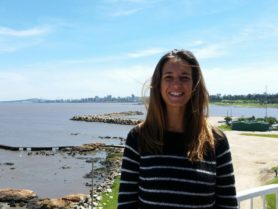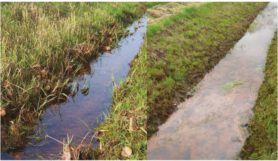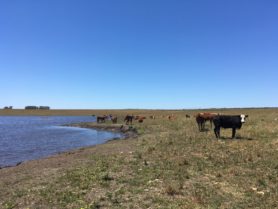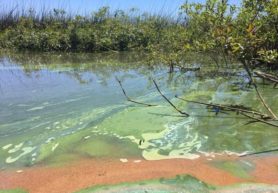Victoria Barcala

Fig. 1: Me outside Montevideo’s lighthouse
Hi there! I am Victoria Barcala (ESR 3) and my host institution is Deltares in Utrecht (the Netherlands). Deltares is an independent applied research institute, with lots of expertise on water and subsurface. Deltares has a huge knowledge on delta system modelling on both physical modeling on the Delta flume and numerical modelling on their software: Delft3D, SOBEK DWAQ. Deltares also has a great geochemical lab together with Utrecht University and TNO. And since the last weeks of October 2019 I have been working on “Improving the management practices of surface waters draining agricultural areas to optimise the retention and recovery of Iron – associated Phosphorus”.
I am interested in Iron and Phosphorus cycles, groundwater to surface waters fluxes, introducing Iron associated Phosphorus processes and transport into water quality models, sedimentation and erosion of Phosphorus stored in bed sediments. I will try to incorporate, modelling, lab work and fieldwork into my work.
My research is a continuation of the work done by Bas Van der Grift, a former Deltares colleague, that did extensive research and published very interesting work on geochemical and hydrodynamic Phosphorus retention mechanisms in lowland catchments. From Bas’s work, we know that the transport and bioavailability of Phosphporus in surface waters in the Netherlands is strongly determined by the Iron present in groundwater.

Fig. 2: Process of Iron (II) oxidation as it extra filtrates from ground-water to surface waters capturing the available dissolved Phosphorus in presence of oxygen (left). Iron oxide in the groundwater-surface water interface (right)
Iron is usually present in reduced form in groundwater but becomes oxidised when the water is flows into the surface. Phosphorus, if present, will bind to the Iron, resulting to the formation of Iron-(Hydr)oxyphosphates. In The Netherlands, more than 60% of the total P concentration in surface waters is bound to particulate Iron. This Phosphorus form is not readily bioavailable but accumulates in the sediment in ditches and canals. My supervisor at Deltares is Leonard Osté, an expert on sediment–water interactions. I am also enrolled at Utrecht University, and supervised by Thilo Behrends whose research focuses on redox transformations. Their knowledge is incredibly relevant for this project and I am looking forward to learning a lot from them!
I am just starting but we already have great ideas for this research. For example, developing a map of shallow ground water quality and analyzing it’s influence on surface water quality. We will be using some large national databases available and collaborating with other Deltares’ projects. For this part of the research we will be exploring some novel techniques such as machine learning and satellite/drone image analysis.
Another part of our research will focus on the sediment’s processes and transport, both at large scale (rivers) and at farm scale (ditches). The field work will be complemented with lab work for better understanding of what is happening.

Fig. 3: Field ditch in the late summer (left) and winter (right). The red sediment indicates the presence of iron hydroxides during winter. Author Bas van der Grift
My secondments will be at ARCADIS, University of Deltares, and KU Leuven. ARCADIS is a consultancy firm with ongoing projects on Phosphorus removal in lakes and surface waters. My secondment here will focus on evaluating existing P-TRAP measures on the long term, their effectiveness, and its acceptance by farmers and cost. On my secondment at Utrecht University I will learn laboratory techniques essential for the planned lab work. In KU Leuven, I plan to carry will deal with flume experiments on sediment transport, determining the influence of different Phosphorus/Iron ratio, dissolved oxygen concentrations, and temperature on the flocculation and settling of Phosphorus rich sediments.
I will be working closely with ESRs 6 and 11 on the lab as they are also based in Utrecht and we will be sharing facilities. A closed collaboration with ESR 7 will also be necessary as his secondment will be at Deltares to work also on P-rich sediments.
About myself, I have a Civil engineering background, I did my MSc at IHE in Delft (the Netherlands), I focused my Thesis on Phosphorus recovery from point sources with Magnesium and Calcium addition to obtain fertilizers. Management of Phosphorus surpluses has always fascinated me, after my research on point sources I realized the critical issue was diffuse Phosphorus contamination from agricultural areas, that is where the higher loads are coming from and where it is critical to act. This is one of the reasons why working on P-TRAP motivates me so much!
I come from Uruguay, an agriculture-based country in the south of South America where eutrophication is becoming a bigger a bigger issue in drinking water sources and recently because of toxins present in the beaches in the summer. I share some pictures below for you to get an idea. This is the other reason why I feel so grateful to be part of the P-TRAP network and hope to make the most out of the research.

Fig. 4: Uruguayan typical countryside landscape. Author: Peer Voss |

Fig. 5: Algae bloom Summer 2017, shallow lake used as Drinking water source in Uruguay. It was a severe taste and odor episode that signified high costs on Granule Activated Carbon. |

Fig. 6: Algae bloom Summer 2019 in the Estuary and Atlantic coast of Uruguay with impact on tourism and recreational activities. |
On my free time I enjoy music, spending time outdoors, doing sports, and travelling. I am looking forward to the work ahead and to keeping you posted about it! Stay tuned for new posts!
Cheers!
Victoria

